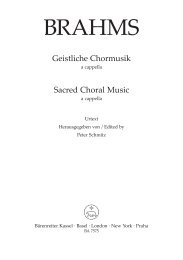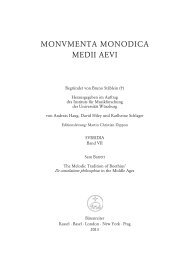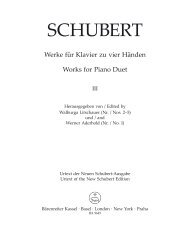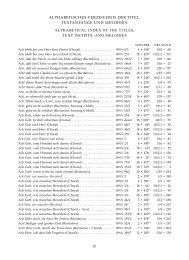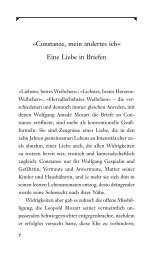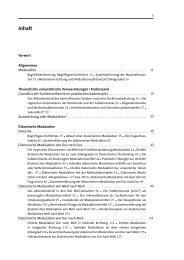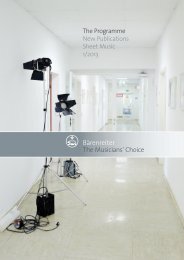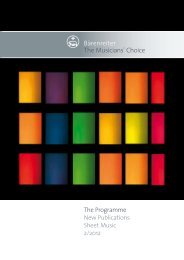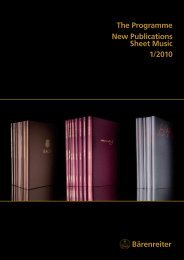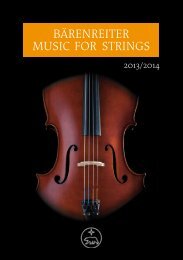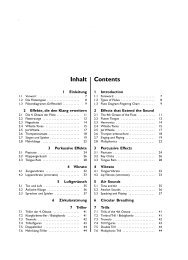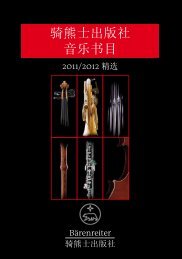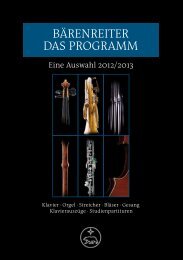Sämtliche Vokalwerke - Bärenreiter Verlag
Sämtliche Vokalwerke - Bärenreiter Verlag
Sämtliche Vokalwerke - Bärenreiter Verlag
Sie wollen auch ein ePaper? Erhöhen Sie die Reichweite Ihrer Titel.
YUMPU macht aus Druck-PDFs automatisch weboptimierte ePaper, die Google liebt.
England along with these latter works. 4 Finally, some features of the berg, which is not to preclude the possibility that the piece wasmusic imply that it originated after 1700 at Pachelbel’s final place of composed in Pachelbel’s Erfurt years and that the composer tookemployment. One is the lavishness of the instrumental part, which the performance material with him among his personal belongings.was conceived for a professional ensemble; another related feature In this case, the score of the instrumental bass part was probablyis the key of E major, which was not widely used at the time. No less altered to the then novel Basson (instead of a violone or bassoon) forsignificant are the elegance and economy with which the pictorial use in Nuremberg.elements of the text are taken up; the sections follow each other Unfortunately the search for a suitable original text has producedtersely to apposite effect. 5 The very subtlety of the setting of verse 5, no results that might answer the question of where, and thus when,“Dennoch soll die Stadt Gottes fein lustig bleiben mit ihren Brünnlein” (“There the piece originated. The hymn text in the sources fails to match anyis a river, the streams whereof shall make glad the city of God”), of the versions handed down in contemporary hymnals. Worse still,merits attention: rather than illustrating the pictorial “streams,” it has idiosyncratic variants that point to a special tradition, deliberatemodification, or even the inaccuracy of being written down fromPachelbel lends decorous bourgeois expression to the quiet joy of“make glad.” The diminished seventh chord interpolated in bar 34 memory. 9 Even in church music that was publicly “regulated” in onesolely for expressive effect is rarely encountered in the church music way or another, the process by which the words of a contrapuntalof the time, and may be a further indication of Pachelbel’s penchant piece were chosen – which source? which premises? prepared byfor musical rhetoric.whom? – is one of those matters that left behind practically no writtendocumentation, and thus elude reconstruction. As a rule, anyIn the case of the two “chorale cantatas” Christ lag in Todes Banden andWas Gott thut das ist wohl gethan, the music historian’s first instinct is departures from potential original sources are assumed to representto assume that both pieces, being sacred concertos on multi-stanza the creative will of the author. To illustrate this point with a singlechurch hymns, date from Pachelbel’s Erfurt period. It was Erfurt detail, Luther’s words call for a demonstrative pronoun in the thirdwhere the employers and congregation paid special attention to the line of the first stanza: “Christ lag in Todes Banden … der ist wieder erstanden.”In the concerto the text is weakened by the use of a per-manner in which the organist accompanied church hymns. His certificateof appointment at the Predigerkirche expressly calls for “thematicepraeambulando” before the congregational singing. 6 It was here happen to contain this variant, e.g. the new impression of Petersonal pronoun: “… er ist wieder erstanden.” In fact, a few hymnalsthat Pachelbel’s brilliant impact as an organist even gave rise to the Sohren’s Praxis pietatis melica (Frankfurt am Main, 1674) and the ReussHymnal (Jena, 1689). 10 This would fit in well with Pachelbel’sfirm music-historical label “Pachelbel type” of chorale setting, particularlyfor keyboard instruments. Yet it has since been discovered tenure in Erfurt. But it only shifts the problem of the origin of thethat other Nuremberg organists were wholly familiar with the use words, as can be seen in the fact that both hymnals, besides a fewof Vorimitation and integrative forms of chorale arrangement; indeed, other minor discrepancies, place the three-syllable “bezwingen” at thethe “Pachelbel type” might just as well have been named after his beginning of the second stanza instead of “zwingen.”Nuremberg predecessor Georg Caspar Wecker. 7 Whatever the case, The treatment of the second chorale cantata, Was Gott thut das ist wohlthe wide-ranging practice of chorale arrangements for voices and gethan, brings us somewhat closer to Pachelbel’s Erfurt period, ifinstruments in central and northern Germany points to a historical only because of the hymn on which it is based. 11 Chronologically, itcontext in which both Pachelbel works can take a legitimate place. is the most recent of those seventeenth-century hymns that haveBefore pursuing further thoughts along these lines, let us briefly enjoyed a certain popularity to the present day. To a great extent itexamine the findings from the surviving musical documents.probably owes its popularity to its melody, whose simple style isBoth pieces have come down to us only in copyists’ manuscripts. designed for easy reception, and it comes as no surprise to discoverMoreover, both have been passed down in different source traditions,which makes it necessary to discuss them separately. Christ lag peared in print. (Nor is it surprising that the tune can be seen as athat the tune was already given new verses even before it had ap-in Todes Banden is related by paper brand to several other musical simplification of an existing melody.) 12 If the author of the words, amanuscripts known to have originated during Pachelbel’s Nurembergyears, not least the concerto Jauchzet dem Herren (PWV 1217), was based in Jena until 1680, actually wrote the words to this hymntheologian and scholastic named Samuel Rodigast (1649-1708) whowhich dates from 1704. 8 Similarly, the handwriting of the several in 1675, as legend has it, then it took little more than a year beforecopyists who produced the set of parts for Christ lag in Todes Banden they reached print. Remarkably, it is this early version of the hymnis related to other “Nuremberg” compositions by Pachelbel. For example,the scribe who wrote out the first violin part is identical to tata. 13 Soon a process of revision set in during which the words werethat comes closest to the underlying text of Pachelbel’s chorale can-the one who wrote out the soprano and alto parts of the G-minor altered in significant passages. For example, it is not inconsequentialMagnificat (PWV 1503), which dates from 1705; and the scribe of the whether, in the third line of the first stanza reads “meine Sachen” (myfirst page of the tenor part of that work probably wrote the alto part affairs) or “seine Sachen” (His affairs)’. The former reading is alreadyof the chorale cantata. It is also safe to assume that the principal found in Erfurt 1682, Gotha 1683, and Ansbach 1684, but not inscribe of the set of parts for the above-mentioned Jauchzet dem Herren Pachelbel’s text. 14 And even if the hymn was published for the firstis identical to the one who wrote the soprano and second violaparts. Thus the handwriting and paper analysis point to Nurem-9 See the wording of the text on p. 200 of the appendix to the presentvolume.4 10See Henry Woodward: “A Study of the Tenbury Manuscripts of Johann Johann Crügers Neu zugerichtete PRAXIS PIETATIS MELICA […] (FrankfurtPachelbel” (PhD diss., Harvard University, 1952). The psalms are discussed am Main: Wust, 1674); Reußisches vollständiges Gesang- und Handbuch […] (Jena:on pp. 270–310, Psalm 46 on pp. 299–310.Oehrling, 1689).5 Woodward, “Study” (see note 4), and idem: “Musical symbolism in the11 Further information on the hymn can be found on p. 201 of the appendixvocal works of Johann Pachelbel,” Essays on music in honor of Archibald Thompson to the present volume.12Davison (Cambridge, MA, 1957), pp. 225–34, esp. pp. 226–28.The melody was composed by the Jena cantor Severus Gastorius (1646–6Reproduced in Johann Pachelbel: 94 Kompositionen: Fugen über das Magnificat für 1682). On the melody see Siegfried Fornaçon: “Werke von Severus Gastorius,”Jahrbuch für Liturgik und Hymnologie 8 (1963), pp. 165–70.Orgel oder Klavier, ed. Hugo Botstiber and Max Seiffert, Denkmäler der Tonkunst13in Österreich VIII/2, vol. 17 (Vienna, 1901; repr. Graz, 1959), pp. vii f.Appendix to Das Hannoverische […] Vollständige Gesangbuch (Göttingen:7 The question of the “Pachelbel type” in vocal music is discussed in Krummacher:Kantate, pp. 373–75, and the preface to Deutsche Orgel- und Claviermusik deutsche evangelische Kirchenlied des 17. Jahrhunderts 4 (Gütersloh, 1908; repr. Hild-Schmidt, 1676); text reproduced in Albert Fischer and Wilhelm Tümpel: Dasdes 17. Jahrhunderts: Werke in Erstausgaben, ed. Siegbert Rampe (Kassel: <strong>Bärenreiter</strong>,2003), p. ix.Allgemeines | Vest=Büchlein […], ed. Johann Pistorius (Erfurt: Michael, 1682),esheim, 1964), pp. 379f.148 Paech, pt. 1, p. 38. See also p. 208 of the present volume. pp. 14f. of the musical section; “Vollständiges und Mit schönen geistlichenXIII



